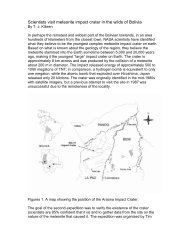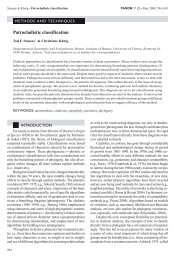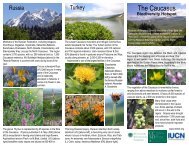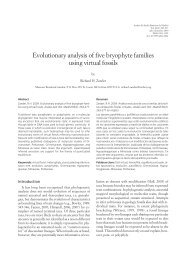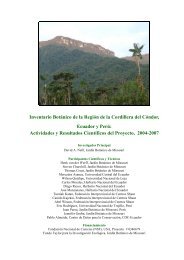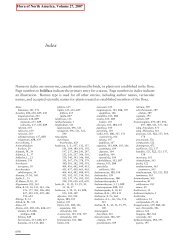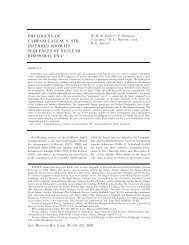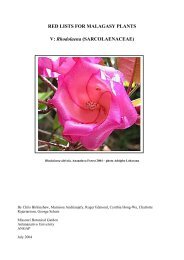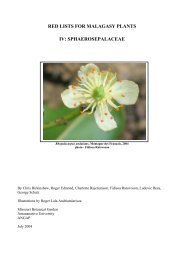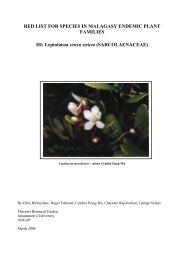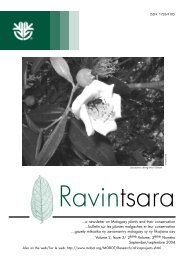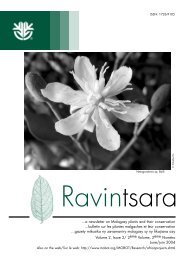re-evaluation of tortella - Missouri Botanical Garden
re-evaluation of tortella - Missouri Botanical Garden
re-evaluation of tortella - Missouri Botanical Garden
You also want an ePaper? Increase the reach of your titles
YUMPU automatically turns print PDFs into web optimized ePapers that Google loves.
the absence <strong>of</strong> quadrate cells on the adaxial surface <strong>of</strong><br />
the costa is characteristic <strong>of</strong> that species. The substrate,<br />
at the base <strong>of</strong> a cottonwood t<strong>re</strong>e, is not typical <strong>of</strong> that<br />
species.<br />
One alternative is that the collection seen was<br />
Tortella alpicola. Crundwell had seen and annotated<br />
several specimens <strong>of</strong> that species from North America<br />
in North American herbaria, speculating that they had<br />
an affinity with Tortella rigens due to their leaf cells<br />
attaining 14 µm. Tortella alpicola has been <strong>re</strong>cently<br />
<strong>re</strong>ported from Alberta (Eckel 1997). I<strong>re</strong>land et al. (1987)<br />
in their checklist <strong>of</strong> the mosses <strong>of</strong> Canada conside<strong>re</strong>d<br />
the variety Tortella flavovi<strong>re</strong>ns var. gla<strong>re</strong>icola to be<br />
excluded from Canada.<br />
3. TORTELLA ALPICOLA Plate 3<br />
Tortella alpicola Dix., Ann. Bryol. 3: 54. 1930.<br />
Sarconeurum tortelloides S. W. G<strong>re</strong>ene, Sci.<br />
Rep. Brit. Antarct. Surv. 64: 38. 1970.<br />
Tortella tortelloides (S. W. G<strong>re</strong>ene) Robins. in<br />
Llano, Antarct. Terr. Biol., Antarct.<br />
Res. Ser. 20: 170. 1972.<br />
Tortella fragilis var. tortelloides (S. W.<br />
G<strong>re</strong>ene) Zand. & Hoe, Bryologist 82:<br />
84. 1979.<br />
Plants scatte<strong>re</strong>d or in s<strong>of</strong>t, loose or close tufts,<br />
light or dark and vivid or clear g<strong>re</strong>en above, pale buffbrown<br />
below with glistening white leaf bases, elongate,<br />
not rosulate. Stems thin, slender, 0.5–1(–1.5) cm,<br />
branches few to several, central strand p<strong>re</strong>sent and<br />
conspicuous, not tomentose except in perichaetiate<br />
plants. Stem leaves loosely foliose, densely so in<br />
perichaetiate plants, appearing s<strong>of</strong>t but actually rather<br />
rigid, fragile, closely to loosely agg<strong>re</strong>gated, uniform in<br />
size, apices in sterile plants (except the youngest)<br />
usually fallen, incurved-circinate and weakly contorted<br />
when dry, e<strong>re</strong>ct-sp<strong>re</strong>ading, occasionally patent when<br />
moist, gradually long-lanceolate, 1.5–2 mm; base<br />
undiffe<strong>re</strong>ntiated or somewhat broader than the limb,<br />
elliptical; margins <strong>of</strong> some leaves weakly undulate,<br />
constricted, lobed in scallop-shapes in several places<br />
distally, e<strong>re</strong>ct to incurved; apex narrowly acuminate,<br />
occasionally sharply contracted into a subula in the<br />
apical 1/3, this a papillose cylinder about the size <strong>of</strong> the<br />
costa, composed <strong>of</strong> a series <strong>of</strong> bar<strong>re</strong>l-shaped<br />
constrictions disarticulating in segments, intact subula<br />
and tip <strong>of</strong> propaguloid apex with an apiculus <strong>of</strong> several<br />
cells, this usually dentate and tipped by one or two,<br />
elongate, sharply pointed clear cells, in sterile plants<br />
leaf apices caducous along zones <strong>of</strong> weakness, youngest<br />
leaves at the stem tips composed enti<strong>re</strong>ly <strong>of</strong> a serially<br />
constricted, multistratose, awl-shaped propagulum,<br />
these usually absent in matu<strong>re</strong> leaves; costa shortexcur<strong>re</strong>nt,<br />
in leaves <strong>of</strong> fertile plants adaxial surface<br />
cove<strong>re</strong>d distally by an epidermis <strong>of</strong> quadrate, papillose<br />
laminal cells, back <strong>of</strong> the costa smooth throughout—in<br />
leaves <strong>of</strong> fragile sterile plants abaxial costa surface<br />
smooth only below apical subula, densely papillose on<br />
12<br />
both adaxial and abaxial surfaces in the distal<br />
subulate <strong>re</strong>gion, in cross section cells weakly<br />
diffe<strong>re</strong>ntiated and f<strong>re</strong>quently rather chaotic, adaxial<br />
epidermis always p<strong>re</strong>sent, rather thin-walled adaxial and<br />
abaxial subste<strong>re</strong>id layers p<strong>re</strong>sent, the adaxial ste<strong>re</strong>id<br />
cells <strong>of</strong>ten disappearing in the distal <strong>re</strong>gion <strong>of</strong> the leaf,<br />
guide cells in one row, <strong>of</strong>ten chlorophyllose; proximal<br />
laminal cells abruptly diffe<strong>re</strong>ntiated from distal cells,<br />
distinct in color, cell size, cell wall thickness and<br />
papillosity, pale white-hyaline and transpa<strong>re</strong>nt, shaped<br />
marginal angles <strong>of</strong> diffe<strong>re</strong>ntiated proximal cells steep;<br />
distal laminal cells <strong>re</strong>latively large, 10–14 µm wide,<br />
lamina unistratose but appa<strong>re</strong>ntly bistratose at junctu<strong>re</strong><br />
<strong>of</strong> lamina and costa, especially along the distal costa in<br />
propaguloid leaves <strong>of</strong> sterile plants; marginal cells<br />
undiffe<strong>re</strong>ntiated, papillose-c<strong>re</strong>nulate throughout.<br />
Asexual <strong>re</strong>production: modification for asexual<br />
<strong>re</strong>production in two modes, a general fragility <strong>of</strong> the leaf<br />
lamina as well as smaller, s<strong>of</strong>t, multistratose,<br />
propaguloid deciduous leaf apices articulated by <strong>re</strong>gular<br />
constrictions, falling early in units <strong>of</strong> approximately<br />
uniform length. Leaf apices generally absent due to the<br />
modified apices falling <strong>of</strong>f when the young leaves we<strong>re</strong><br />
formed, ra<strong>re</strong>ly <strong>re</strong>tained on matu<strong>re</strong> leaves. Sexual<br />
condition: appa<strong>re</strong>ntly dioicous. Perigonia not seen.<br />
Perichaetiate stems tomentose, perichaetia terminal on<br />
successive perichaetial innovations; outer perichaetial<br />
leaves diffe<strong>re</strong>ntiated, especially evident when dry,<br />
longer than the cauline leaves, long-lanceolate to linearlanceolate,<br />
fragile, tipped with long, rigid, subulate,<br />
smooth awns; these leaves rise above the contorted stem<br />
leaves when dry, proximal <strong>re</strong>gion broad, generally<br />
concolorous with the lamina, lamina quickly<br />
disappearing into the costa, or appearing to clothe the<br />
costa in a margin one or two cells wide for a distance<br />
befo<strong>re</strong> disappearing altogether, not propaguloid,<br />
unborde<strong>re</strong>d; inner perichaetial leaves long-triangular.<br />
Sporophytes unknown.<br />
Associated with shaded or exposed, wet or dry<br />
rocks, c<strong>re</strong>vices and ledges <strong>of</strong> granite, quartzite, schist,<br />
sandstone and calca<strong>re</strong>ous outcrops on cliffs and in<br />
canyons, in cracks in a limestone gully in a cavern on<br />
Ellesme<strong>re</strong> Island, but also in wet, mesic tundra (in the<br />
Yukon), and on a wet log (in Montana), in Quebec on<br />
dry limestone cliff face facing north; elevation 25–3300<br />
m; Alta., N.W.T., Que., Yukon; Alaska, Ariz., Colo.,<br />
Idaho, Mont., Nebr., Utah, Wyo.; South America in<br />
Colombia, Asia in India, Pacific Islands in Hawaii,<br />
Antarctica (Alexandra I.). I have verified all extra-<br />
American <strong>re</strong>cords he<strong>re</strong> cited.<br />
Herbaria examined: BUF, CANM, COLO,<br />
DUKE, MICH, MNA, MO, NY, UBC.<br />
The species in North America is associated<br />
with a western corridor <strong>of</strong> both montane and valley<br />
habitats, including the western G<strong>re</strong>at Plains, extending<br />
in an arc from Arizona to Ellesme<strong>re</strong> Island. The location<br />
<strong>of</strong> far eastern stations in the Gasp‚ Peninsula, Quebec<br />
(Mont Commis, St.-Donat de Rimouski, Lepage 3412<br />
MT; Compt‚ Gasp‚-Est, Cap-des Rosiers-Est, Forillon<br />
National Park, Brodo 18646 CANM) seems strikingly





